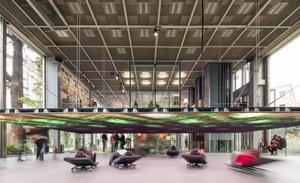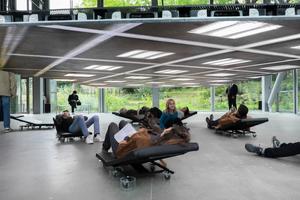MUSINGSONAGLASSBOX
FONDATIONCARTIERPOURLARTCONTEMPORAIN,PARIS,FRANCE
Musings on a Glass Box was conceived in dialogue with its site — the Fondation Cartier, designed by Jean Nouvel and completed in 1994. The building’s distinctive glass galleries have been a provocation to artists and curators for decades, upending the conventions of the white cube. By pushing the limits of glass technology, the building aspired to one of Modernism’s highest goals: to dematerialize the wall and seamlessly connect interior to exterior.
The installation empties the two ground-floor galleries in order to put them on display. Their visual and acoustic qualities are heightened by a few strategic interventions to the building’s facade and to the plumbing and electrical systems. The floor-to-ceiling glass is covered with liquid crystal film that slowly pulses between transparent and translucent states, alternately exposing views to the garden or obscuring them behind a screen of diffuse light, allowing the empty space to breathe in and out. The rest of the building’s interventions are carried out with the help of a robotic bucket, a chorus of voices, sensors, a remote communications system, video equipment, and real-time sound processing. The two ground-floor galleries are connected by sound and video feeds to form a live feedback loop. Minor events in the large gallery are magnified in the smaller one, making the familiar seem uncanny and turning the banal into the grotesque.
There is a mischievous leak from the ceiling of the larger gallery that never stays in one place. The protagonist is a simple but seemingly clairvoyant bucket that has the monotonous task of collecting water droplets from the ceiling. When visitors enter the empty gallery and see a lone bucket, they assume the space is closed for repair. But a closer look reveals that the bucket is not static. It glides on invisible wheels from one location to the next in anticipation of a new leak and always gets there in the nick of time to catch the water droplet.
A video camera is submerged in the water at the bottom of the bucket. This “bucket cam” gazes up at the ceiling as it roams the large gallery looking for leaks. Each droplet is captured on video as it lands in the water and is broadcast in real time to a giant LED screen, suspended facedown, hovering three feet above the floor of the small gallery. The bucket-cam view is revealed to visitors who slide under the screen on low-profile, wheeled platforms typically used by auto mechanics. The one-foot-diameter mouth of the bucket is magnified to fill the sixteen-by-twenty-two-foot screen. As each droplet falls and disturbs the water surface, the smallest ripple appears as a giant tidal wave of swirling, psychedelic light and color.
A contact microphone within the bucket transmits the sound of each droplet to the gallery’s sound system, filling the ground floor with visceral tones that reverberate within the glass-enclosed volume. The normal sound of a droplet’s impact on the surface of water is defamiliarized as it is combined with the sound of a human voice. The noise of each drip is amplified and fed into a processor programmed with an algorithm that morphs its tone to match one of more than fifty prerecorded phrases. As droplets accumulate, the phrases, sung by six separate vocalists, layer on top of one another to form a growing chorus, a new composition created in real time. With sustained reverberation that trails off into silence, the galleries take on the depth and resonance of a cathedral. No part of the evolving composition would ever repeat during the installation’s four-month run.
Musings on a Glass Box was created in collaboration with composer David Lang assisted by sound artist Jody Elff. The project was commissioned by the Fondation Cartier.
| Location Fondation Cartier pour l'art contemporain, Paris, France |
| opening25th October 2014 | closed22nd February 2015 |
| Team | Elizabeth Diller,Ricardo Scofidio,Matthew Johnson,Trevor Lamphier,and Dustin Tobias |
| David Lang | |
| Jody Elff | Sound Design |
| Perfection Electricks | Engineering |





